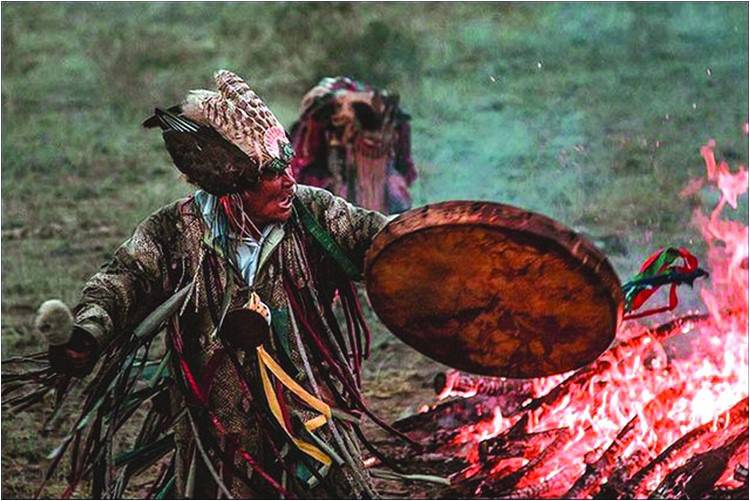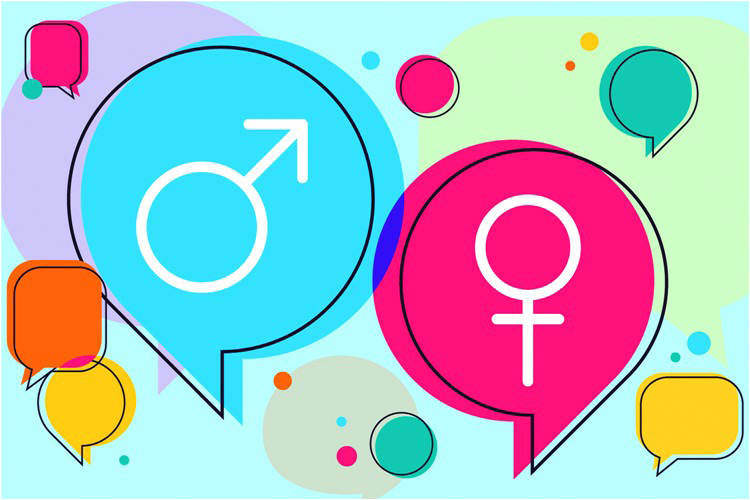
I met a shaman at an afterparty for an art opening this weekend. Tall, bearded and dressed in a cascade of beads and ropes, they introduced themselves to me as Azeru Nushta.
“I’m a nonbinary spiritualist,” they explained, one who “exists outside of gender stereotypes, pronouns or clothes”. I nodded, hoping the buzzwords may mitigate the semi-racist native American costume they had on. We got to chatting about gemology and reiki. All around us were dozens of fabulously dressed people. Anyone of whom could have also been a non-binary shaman.
That makes sense, because at this show some the work was about the idea of gender stereotypes. As usually happens at art openings, the attendees were as much works of art as the actual work. There were hundreds of people dressed across a rainbow spectrum of clothing and being there felt like seeing a fashion parade of moodily silent Instagrammers performing their best life. Take for example the fact that while I was standing and looking at a painting, a young man wearing a vest and little else came to stand next to me and began crying. First I ignored it, but pretty soon the sniffles turned to dry heaving and I began making obvious sideways glances like an old woman at a train station. Then a girl walked up next to him - a tall blond dressed in a woolen polo neck in June - and took a silk hankie from out of her sleeve like a French viscount to pat the tears from his cheeks.
I retreated far away, hoping they didn’t clock my intrusion into their privacy. Seeing someone cry makes me uncomfortable enough that I do not go to funerals or quls for fear of seeing an errant tear. Interested as I am in the rituals of grief - in the ideas of loss, of rites, or afterlives - its expressions leave me feeling sick. It wasn’t until very, very recently that I began to examine why.
I wasn’t always afraid of tears. As a child I remember crying a lot: I cried terribly hard the first day my father dropped me off at school. I remember crying when I got stung by a small jellyfish at the beach in Karachi (more out of shock than pain) and I also remember crying after I saw the 1970s King Kong for the first time. But pretty early on I learned that while it was OK to cry at home, it was not OK to cry outside of it. Particularly at school – where if a boy cried because he scraped his knee, or hurt his arm, or felt scared of the Islamiyat teachers’ stories of djinns, he was nearly always told to stop. “Boys don’t cry,” the teachers always said, “Boys are tough.”
For years I thought the girls schools were Edens of emotionally open golden fields of expressed feelings.

Most of what we learn at school we learn from watching others, and in an all-boys school everyone was watching to see if you cried because crying made you weak and weakness made you a girl and that was bad. Nonsense, of course, but this short line becomes the running mantra inside the head of most boys I have ever known, and does more to shape the performance of our personalities than any other assumption. Which is something that was so odd because even at the time I remember thinking boys were far more emotional than girls. Most of the girls I knew were very together and remarkably mature, while the boys were messes. The difference was just that girls were not encouraged to show that side to them, while the only emotion that boys were allowed to display was anger. Why was it that by the second grade I knew it would be better for me to hit a kid during break time than to cry during class, despite the fact that I had done neither? How did I learn that – if it were not shown to me that Anger was a barometer for something that was being measured for me? Aggression was an acceptable proto-emotion to manliness, but gentleness, kindness and empathy were not.
That’s what people mean when they say things like Gender is a Construct. Its not simply to be difficult. Our attitudes to gender define not only how we see bodies, but also the way we see the world. Much like Urdu, German and Spanish all use genders for inanimate objects and many studies have sought to study the unintended bias this gender assignment can encourage.
Across the board, object gender influenced the participants’ judgments. For example, the word “key” is masculine in German and feminine in Spanish. German speakers tended to describe keys as hard, heavy, jagged, metal, and useful. Spanish speakers, on the other hand, used words such as golden, intricate, little, lovely and tiny. The word “bridge” is feminine in German and masculine in Spanish. Sure enough, German speakers described bridges as beautiful, elegant, fragile, pretty, and slender, while Spanish speakers said they were big, dangerous, strong, sturdy, and towering.
Words matter, particularly words that purport to tell you what is right and what is wrong.
I’ve begun to find the many ways this programming affects my own limits of empathy, vulnerability, and kindness. Exorcising the demons that came with lines like “boys don’t cry” or “that’s so girly” because the truth is they’re both BS. Boys should cry, Girls are tough and the world is non-binary. Especially Shamans.
Write to thekantawala@gmail.com
“I’m a nonbinary spiritualist,” they explained, one who “exists outside of gender stereotypes, pronouns or clothes”. I nodded, hoping the buzzwords may mitigate the semi-racist native American costume they had on. We got to chatting about gemology and reiki. All around us were dozens of fabulously dressed people. Anyone of whom could have also been a non-binary shaman.
That makes sense, because at this show some the work was about the idea of gender stereotypes. As usually happens at art openings, the attendees were as much works of art as the actual work. There were hundreds of people dressed across a rainbow spectrum of clothing and being there felt like seeing a fashion parade of moodily silent Instagrammers performing their best life. Take for example the fact that while I was standing and looking at a painting, a young man wearing a vest and little else came to stand next to me and began crying. First I ignored it, but pretty soon the sniffles turned to dry heaving and I began making obvious sideways glances like an old woman at a train station. Then a girl walked up next to him - a tall blond dressed in a woolen polo neck in June - and took a silk hankie from out of her sleeve like a French viscount to pat the tears from his cheeks.
Why was it that by the second grade I knew it would be better for me to hit a kid during break time than to cry during class, despite the fact that I had done neither?
I retreated far away, hoping they didn’t clock my intrusion into their privacy. Seeing someone cry makes me uncomfortable enough that I do not go to funerals or quls for fear of seeing an errant tear. Interested as I am in the rituals of grief - in the ideas of loss, of rites, or afterlives - its expressions leave me feeling sick. It wasn’t until very, very recently that I began to examine why.
I wasn’t always afraid of tears. As a child I remember crying a lot: I cried terribly hard the first day my father dropped me off at school. I remember crying when I got stung by a small jellyfish at the beach in Karachi (more out of shock than pain) and I also remember crying after I saw the 1970s King Kong for the first time. But pretty early on I learned that while it was OK to cry at home, it was not OK to cry outside of it. Particularly at school – where if a boy cried because he scraped his knee, or hurt his arm, or felt scared of the Islamiyat teachers’ stories of djinns, he was nearly always told to stop. “Boys don’t cry,” the teachers always said, “Boys are tough.”
For years I thought the girls schools were Edens of emotionally open golden fields of expressed feelings.

Most of what we learn at school we learn from watching others, and in an all-boys school everyone was watching to see if you cried because crying made you weak and weakness made you a girl and that was bad. Nonsense, of course, but this short line becomes the running mantra inside the head of most boys I have ever known, and does more to shape the performance of our personalities than any other assumption. Which is something that was so odd because even at the time I remember thinking boys were far more emotional than girls. Most of the girls I knew were very together and remarkably mature, while the boys were messes. The difference was just that girls were not encouraged to show that side to them, while the only emotion that boys were allowed to display was anger. Why was it that by the second grade I knew it would be better for me to hit a kid during break time than to cry during class, despite the fact that I had done neither? How did I learn that – if it were not shown to me that Anger was a barometer for something that was being measured for me? Aggression was an acceptable proto-emotion to manliness, but gentleness, kindness and empathy were not.
That’s what people mean when they say things like Gender is a Construct. Its not simply to be difficult. Our attitudes to gender define not only how we see bodies, but also the way we see the world. Much like Urdu, German and Spanish all use genders for inanimate objects and many studies have sought to study the unintended bias this gender assignment can encourage.
Across the board, object gender influenced the participants’ judgments. For example, the word “key” is masculine in German and feminine in Spanish. German speakers tended to describe keys as hard, heavy, jagged, metal, and useful. Spanish speakers, on the other hand, used words such as golden, intricate, little, lovely and tiny. The word “bridge” is feminine in German and masculine in Spanish. Sure enough, German speakers described bridges as beautiful, elegant, fragile, pretty, and slender, while Spanish speakers said they were big, dangerous, strong, sturdy, and towering.
Words matter, particularly words that purport to tell you what is right and what is wrong.
I’ve begun to find the many ways this programming affects my own limits of empathy, vulnerability, and kindness. Exorcising the demons that came with lines like “boys don’t cry” or “that’s so girly” because the truth is they’re both BS. Boys should cry, Girls are tough and the world is non-binary. Especially Shamans.
Write to thekantawala@gmail.com

